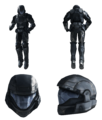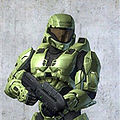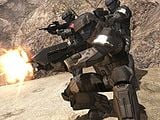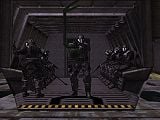ODST armor
From Halopedia, the Halo wiki
The ODST Battle Armor or Battle Dress Uniform is a suit of combat armor worn exclusively by the Orbital Drop Shock Troopers, special-operators of the UNSC Marine Corps.
Introduction
The ODST Battle Dress Uniform is the signature piece of equipment used by the 105th Special Forces - the armor is vacuum-rated, capable of extravehicular activity for fifteen minutes.[1] The armor provides numerous advantages in the field including ballistic protection, and heat resistance from both atmospheric entry and Covenant energy weapons. The ODST Armor has gone through several design changes since the start of the Human-Covenant War. The current version incorporates technology initially developed for the MJOLNIR Armor. This includes CTCs for body armor, Titanium and Ceramic composite armor plating, to give the user added protection - along with HUD and Communications Systems to give more situational awareness to the wearer.[2]
The ODST BDU has been in use for well over 50 years by the 105th, and remains untouched by its ability to protect its wearer during the toughest operations. The BDU excels at providing more protection against small arms fire then other infantry body armor, and also excels at allowing a trooper to conduct Military Operations in Urban Terrain without the slightest chance of being detected in darken locations. The BDUs stealth capability is thanks in part to its black and gray camouflage pattern on the legs, boots, gloves, chest, helmet and undersuit. On the left shoulder pad of every ODST is a UNSC MED REF patch[3] this patch contains basic medical information about the trooper, and allows a UNSC certified medic to gain a quick medical reference to an ODST wounded in the field. Despite the armors obvious advantage over standard infantry armor, it is still vulnerable to Covenant energy weapons and larger armor piercing rounds as well as large explosive devices.
Armor Variants
While the standard ODST BDU is fully capable for any role, there are specialized variants of the BDU - these suits are specifically issued to a specialist of a certain field to provide them certain advantages during an operation. As such specialized gear is only available by Mission Conditional Requisition (MCR). Depending on mission requirements a user may request either additional or variant equipment that ranges from helmet attachment, gloves, battery, equipment or communication rucksack. The following is the specialized battle dress uniforms currently in use by the Navy.
Close Quarters
While designated as a CQB suit this variant is also issued to Demolition experts in the field. This BDU is specifically design to aid a ODST in CQB type combat conditions - the standard left pauldron is replaced with a longer two piece ballistic plate, this aids in protecting the troopers left arm from ballistic attacks and reduce severe injury from Plasma Weapons. The helmet is also issued with an optics device that aids the user in relaying images and video to teammates or command.
Sharpshooter
The Sharpshooter BDU is issued to sniper experts in the field. This BDU is designed to give a ODST sharpshooter more freedom in combat - the standard right pauldron is removed allowing the sniper to aim better and move his arm more freely with a sniper rifle. The standard left pauldron is replaced with a larger plate to protect the snipers arm from counter attacks. The sharpshooter variant is also issued with an optics device attached to the helmet, while the variant oracle scope on the SRS99 can uplink to the users HUD, this device provides a sniper with additional capabilities.
Recon
The Reconnaissance BDU is a specialized Office of Naval Intelligence variant of the ODST Armor. The armor is only issued to ONI reconnaissance agents for high risk operations. The undersuit is the same as the standard ODST armor, however the chest plate is replaced with a specialized one to provide stealth capabilities with little or no loss of endurance, specifically by reducing its IR signature and reflective surfaces. The torso part of the armor also varies from the standard version, having a green, translucent orb in the center. There are no shoulder plates issued with this variant, this allows freedom of arm movement. The helmet is similar to the Recon variant of the MJOLNIR Armor.
Other Versions
There are also variants or models of the ODST armor that have not been named; one example of this is a suit that ODSTs Gretchen, Dutch and Romeo wore during a mission some time prior to the Battle of Ariel. It differed greatly from the normal ODST armor in that it bore a great resemblance to standard Marine armor. The chestplate that Romeo wore was olive drab in color, and appeared almost identical to those worn by the Marines. However, the armor retains the basic form of the ODST armor, with standard helmet and bodysuit pieces obviously shown. It is possible that this variant is either an earlier version of the armor or a field-expedient modification.
Armor Components
The ODST battle dress uniform is made up of several different components and layers that make the suit what it is, while technology from other projects across the military have been incorporated into the suit, ODST equipment still has proprietary technology that has not been adopted into other equipment for the military.
Helmet
The ODST helmet is made of titanium coated with a heat resistance material to help disperse heat, the inside is line with black padding to provide comfort when the user is wearing it - the helmet has a blue faceplate that when polarized obscures the wearers face completely. The helmet provides excellent protection against small arms fire and small explosive attacks. The helmet is also essential in providing an ODST the ability to perform EVA - the helmet also provides a Heads Up Display giving the wearer basic information including a targeting reticule, weapon information and ammo capacity, and basic health readout. The helmets visor can polarize and depolarize, when polarized the wearers HUD is displayed. The newest version of the helmet integrates with the users standard Neural Interface to provide more tactical data to the HUD in addition to the basic display. Helmet integrated neural interfaces is another piece of technology that has seen widespread adoption from Project MJOLNIR.
VISR
- Main article: Visual Intelligence System, Reconnaissance
The Visual Intelligence System, Reconnaissance or VISR, is issued with the ODST helmet. The VISR proprietary data management suite enables a user to link into UEG, CAA, and UNSC infrastructure systems at the local, national, and global levels - however actual access level is administered on a need/rating basis. This allows the user to store and review audio files up to 610MB combined, street level navigational data, and receive secure real-time mission data. In addition, every current issue helmet ODST BIOS A29.817941B.01 or later is equipped with low-light vision enhancement which outlines hostile units in red, friendlies in green and objects of interest in yellow.[4]
Rucksack
The rucksack issued to ODSTs is, for all intents and purposes, an armored backpack that is mounted on the trooper's rear armor. The rucksack seems to come in a number of different variants, however. These include Storage, which allows a trooper to store equipment ranging from ammunition to medical supplies to explosives, Battery Pack, which provides power to any equipment an ODST may carry or find in the field, and Communications, which houses the necessary radio and satellite gear that an ODST squad requires to report in to their superiors.
Body Suit
The ODST body suit is made up of several different layers and materials, the inner layer of the black-gray undersuit is made up of Kevlar material to aid in protecting the wearer from small arms fire, the outer layer of the undersuit is coated with a heat resistance material to aid in reducing temperatures experienced during orbital drop, and against Covenant Plasma Weapons. The body suit also doubles as a pressure suit to allow an ODST to perform EVA. The outer shell layer is comprised of Titanium and Ceramic composite armor plating that covers the chest, shoulders, legs and feet.
Multiplayer Variant
The helmet of the ODST Armor is available as an armor permutation in the Halo 3 Multiplayer component. The SPARTAN version of the helmet differs from the standard version in the polarization color of its visor; regular ODST helmets have blue polarization while the MJOLNIR ODST helmet retains the amber/gold tint possessed by most MJOLNIR armor. It is attained and unlocked by the Spartan Graduate Achievement, or by earning 5 XP in Matchmaking.[5]
Triva
- The ODST armor is derived from the first concept of the MJOLNIR armor, this original concept done by artist Shi Kai Wang was scrapped because it made the Master Chief look "too mean". The helmet serves to distinguish the ODSTs from regular marines.[6]
- The visor's ability to polarize, the VISR mode, and the HUD it displays may mean it has a transparent Organic Light Emitting Diode (OLED) screen coating it.
- Some have speculated that the vacuum-enabled body suit used by the young Spartans on Eridanus Secundus and various other missions - before they recieved their MJOLNIR armor - is the same suit that the ODSTs wear, but this is merely speculation, and has never been confirmed. The vast differences between them strongly suggest that they are not the same suit. For example, while the body suits in The Fall of Reach were so form-fitting that the Spartans could fit coveralls over them, the ODST armor is almost as bulky as the MJOLNIR.
- It should be noted that the armor used by the ODSTs in Halo 3: ODST is similar to the one seen in Halo 3, despite the game taking place during the events of Halo 2. This suggests that the changes between the games are merely aesthetic and that there is no canonical difference between the Halo 2- and Halo 3-era suits.
- At one point in development, the multiplayer ODST helmet had an antenna on its back.[7]
Gallery
- Char odst.jpg
The armor in Halo 2.
Sources
- ^ Halo: The Cole Protocol chapter 4 page 48, chapter 5 page 56
- ^ Halo 3
- ^ We Are ODST, Halo 3: ODST, Halo: Landfall
- ^ Halo 3: ODST
- ^ Halo 3
- ^ The Art of Halo 3
- ^ http://www.gametrailers.com/video/pax-2007-halo-3/24148; the antenna can be glimpsed for a brief moment when the player dies.



